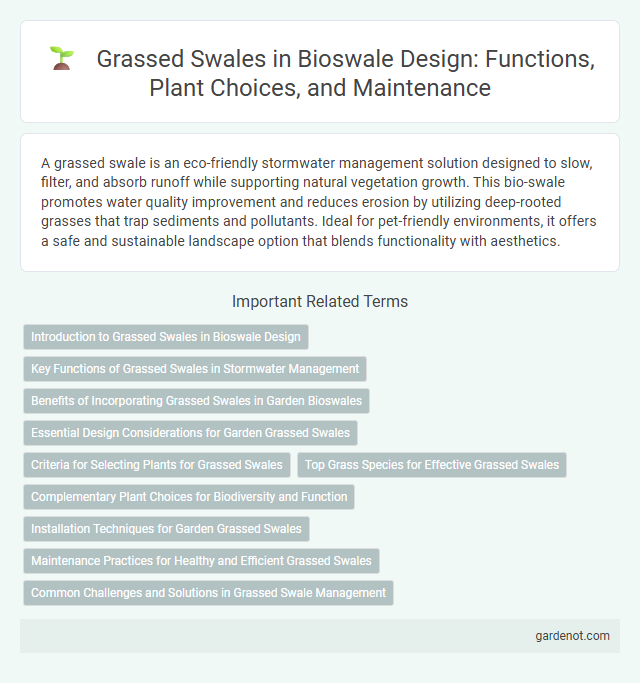A grassed swale is an eco-friendly stormwater management solution designed to slow, filter, and absorb runoff while supporting natural vegetation growth. This bio-swale promotes water quality improvement and reduces erosion by utilizing deep-rooted grasses that trap sediments and pollutants. Ideal for pet-friendly environments, it offers a safe and sustainable landscape option that blends functionality with aesthetics.
Introduction to Grassed Swales in Bioswale Design
Grassed swales are shallow, vegetated channels designed to manage stormwater runoff by promoting infiltration and filtration. These bioswale features reduce pollutants and sediment load while slowing water flow, enhancing groundwater recharge and improving water quality. Integrating native grasses and plants ensures erosion control and supports habitat biodiversity within urban and suburban landscapes.
Key Functions of Grassed Swales in Stormwater Management
Grassed swales play a crucial role in stormwater management by promoting infiltration, filtering pollutants, and reducing runoff velocity. These vegetated channels intercept stormwater, allowing sediment and contaminants to settle while facilitating groundwater recharge. Their design improves water quality and mitigates flooding by controlling the volume and flow rate of stormwater.
Benefits of Incorporating Grassed Swales in Garden Bioswales
Grassed swales enhance garden bioswales by improving stormwater filtration and reducing surface runoff through natural vegetation. Their dense grass roots stabilize soil, prevent erosion, and promote groundwater recharge, supporting sustainable water management. Incorporating grassed swales increases biodiversity and creates habitat for beneficial insects while requiring low maintenance compared to traditional drainage systems.
Essential Design Considerations for Garden Grassed Swales
Garden grassed swales require careful design considerations including appropriate slope gradients between 1-5% to ensure optimal water infiltration and prevent erosion. Selecting native, deep-rooted grasses enhances soil stability and maximizes pollutant filtration effectiveness within the swale system. Proper sizing based on watershed area and anticipated runoff volume is crucial to accommodate stormwater flow while maintaining aesthetic and ecological benefits.
Criteria for Selecting Plants for Grassed Swales
Selecting plants for grassed swales requires assessing local climate adaptability, root structure, and maintenance needs to enhance stormwater infiltration and prevent erosion. Native grasses and deep-rooted species promote soil stabilization and pollutant filtration while reducing irrigation and fertilization demands. Prioritizing drought-tolerant, fast-growing, and disease-resistant plants optimizes the swale's ecological functionality and longevity.
Top Grass Species for Effective Grassed Swales
Top grass species for effective grassed swales include native tall fescue (Festuca arundinacea), buffalo grass (Bouteloua dactyloides), and creeping red fescue (Festuca rubra), known for their deep root systems that enhance soil infiltration and erosion control. These grasses tolerate wet conditions and support pollutant filtration, improving stormwater management in urban and suburban landscapes. Selecting species adapted to local climate and soil conditions maximizes the bio-swale's performance in reducing runoff and enhancing water quality.
Complementary Plant Choices for Biodiversity and Function
Grassed swales benefit from complementary plant choices such as native grasses, sedges, and wildflowers that enhance biodiversity and improve stormwater filtration. Deep-rooted species like switchgrass and little bluestem stabilize soil and promote infiltration, while flowering plants attract pollinators and support local ecosystems. Selecting a diverse plant palette ensures functional resilience and ecological balance within bio-swale systems.
Installation Techniques for Garden Grassed Swales
Garden grassed swales require precise excavation to create gentle, sloped channels that direct stormwater runoff efficiently while preventing erosion. Installing a well-compacted soil base followed by layering native grasses enhances infiltration and pollutant filtration, optimizing water quality management. Proper grading, seed selection, and irrigation during establishment ensure long-term swale effectiveness and durability.
Maintenance Practices for Healthy and Efficient Grassed Swales
Effective maintenance practices for healthy and efficient grassed swales include regular mowing to maintain optimal vegetation height, which enhances infiltration and pollutant removal capabilities. Periodic inspection and removal of accumulated sediment, debris, and invasive plants prevent clogging and preserve hydraulic function. Ensuring proper erosion control through reseeding and prompt repairs maintains slope stability and supports long-term swale performance.
Common Challenges and Solutions in Grassed Swale Management
Grassed swales often face challenges such as erosion, sediment buildup, and inefficient water infiltration, which can reduce their effectiveness in stormwater management. Regular maintenance practices like periodic mowing, sediment removal, and vegetation management help control these issues by promoting healthy grass growth and preventing clogging. Implementing check dams or outlet protection structures also stabilizes flow and mitigates erosion, enhancing the overall performance of grassed swales.
Grassed swale Infographic

 gardenot.com
gardenot.com